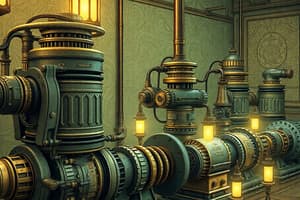Podcast
Questions and Answers
What allows 115VAC to the cooler fan?
What allows 115VAC to the cooler fan?
- The 140K2 relay receives 28VDC from the thermal switch. (correct)
- The UTIL HYD COOLING BLOWER circuit breaker is activated.
- The UTIL BLO CONTR circuit breaker is activated.
- The temperature bulb transmits an electrical signal to the utility hydraulic system fluid temperature indicator.
If the No.1 AC system fails, what will happen to the utility oil cooler fan?
If the No.1 AC system fails, what will happen to the utility oil cooler fan?
- It will continue to operate using the No.1 DC system.
- It will operate at a reduced speed.
- It will not function. (correct)
- It will continue to operate using the 28VDC thermal switch.
What is the purpose of the temperature bulb in the reservoir/cooler system?
What is the purpose of the temperature bulb in the reservoir/cooler system?
- To transmit an electrical signal to the utility hydraulic system fluid temperature indicator. (correct)
- To control the cooler fan operation.
- To provide a visual indication of the fluid temperature.
- To cool the hydraulic fluid.
Where is the thermal switch located in the reservoir/cooler system?
Where is the thermal switch located in the reservoir/cooler system?
What is the temperature at which the cooler fan will be activated?
What is the temperature at which the cooler fan will be activated?
How many sources of electrical power are required for the utility cooler fan to operate?
How many sources of electrical power are required for the utility cooler fan to operate?
What is the relationship between the temperature bulb and the thermal switch in the reservoir/cooler system?
What is the relationship between the temperature bulb and the thermal switch in the reservoir/cooler system?
What is the role of the cooler section in the utility hydraulic system?
What is the role of the cooler section in the utility hydraulic system?
What is the purpose of the brake transfer valve?
What is the purpose of the brake transfer valve?
How many brake master cylinders are there in the system described?
How many brake master cylinders are there in the system described?
What is the pressure used to operate the brake master cylinders?
What is the pressure used to operate the brake master cylinders?
Which part of the brake master cylinder allows pressurized fluid to return to the utility system once the brakes are released?
Which part of the brake master cylinder allows pressurized fluid to return to the utility system once the brakes are released?
What is the role of the springs located in the bottom of the master cylinder?
What is the role of the springs located in the bottom of the master cylinder?
Where are the transfer valves located?
Where are the transfer valves located?
What prevents system pressure from entering the return system during brake application?
What prevents system pressure from entering the return system during brake application?
Which of the following is NOT true about the brake master cylinder system?
Which of the following is NOT true about the brake master cylinder system?
What does the utility hydraulics system provide power for during normal operations and emergency situations?
What does the utility hydraulics system provide power for during normal operations and emergency situations?
Which of the following subsystems is NOT powered by the utility hydraulic system?
Which of the following subsystems is NOT powered by the utility hydraulic system?
What should students recycle? (Select all that apply)
What should students recycle? (Select all that apply)
What is the risk assessment level of the training?
What is the risk assessment level of the training?
Where is the evaluation conducted?
Where is the evaluation conducted?
Which of these is NOT a part of the utility hydraulic system?
Which of these is NOT a part of the utility hydraulic system?
Which of these are NOT mentioned as relevant safety regulations?
Which of these are NOT mentioned as relevant safety regulations?
What is the main purpose of the Pressure Control Module (PCM)?
What is the main purpose of the Pressure Control Module (PCM)?
What is the primary function of the swivel lock pilot solenoid valve?
What is the primary function of the swivel lock pilot solenoid valve?
What pressure must the accumulator be depressurized to for an accurate reading of pre-charge?
What pressure must the accumulator be depressurized to for an accurate reading of pre-charge?
How is the swivel lock engaged when hydraulic pressure is applied?
How is the swivel lock engaged when hydraulic pressure is applied?
What condition must be met for the steering lever to be connected to the actuator rod end?
What condition must be met for the steering lever to be connected to the actuator rod end?
What triggers the out of phase switch in the cam and wheel centering assembly?
What triggers the out of phase switch in the cam and wheel centering assembly?
What action is taken to depressurize the power steering and swivel lock module?
What action is taken to depressurize the power steering and swivel lock module?
What role does the feedback potentiometer play in the power steering actuator assembly?
What role does the feedback potentiometer play in the power steering actuator assembly?
What happens when the switch is set to UNLOCK in the swivel lock actuator?
What happens when the switch is set to UNLOCK in the swivel lock actuator?
What is the pressure differential that causes the DPI button to extend on the filter bowl assembly?
What is the pressure differential that causes the DPI button to extend on the filter bowl assembly?
When does the bypass feature of the filter bowl assembly activate?
When does the bypass feature of the filter bowl assembly activate?
What triggers the PUMP FAULT light on the maintenance panel for the APU motor/pump?
What triggers the PUMP FAULT light on the maintenance panel for the APU motor/pump?
Which of these components is NOT directly related to the ramp operation?
Which of these components is NOT directly related to the ramp operation?
What is the purpose of the Ramp Transfer Cylinder?
What is the purpose of the Ramp Transfer Cylinder?
What happens when the ramp control valve is in the STOP position?
What happens when the ramp control valve is in the STOP position?
Where is the Utility Boost Pump located?
Where is the Utility Boost Pump located?
Which port is open when the ramp control valve is operated to STOP?
Which port is open when the ramp control valve is operated to STOP?
What is the supply pressure for the Utility Boost Pump?
What is the supply pressure for the Utility Boost Pump?
What is the minimum pressure required to unlock the ramp locking mechanism?
What is the minimum pressure required to unlock the ramp locking mechanism?
What is the maximum flow rate of the Utility Boost Pump?
What is the maximum flow rate of the Utility Boost Pump?
In the DN position of the ramp control valve, what is the role of port C3?
In the DN position of the ramp control valve, what is the role of port C3?
Which statement is true about the ramp actuating cylinders?
Which statement is true about the ramp actuating cylinders?
What happens to the fluid during the UP position of the ramp control valve?
What happens to the fluid during the UP position of the ramp control valve?
How many ports do the ramp actuating cylinders have?
How many ports do the ramp actuating cylinders have?
What does the RAMP PWR switch control in the ramp system?
What does the RAMP PWR switch control in the ramp system?
Flashcards
Temperature Bulb
Temperature Bulb
A component that measures the temperature of the hydraulic fluid in the reservoir/cooler and transmits an electrical signal to the maintenance panel.
Thermal Switch
Thermal Switch
A safety device that controls the operation of the cooler fan based on the temperature of the hydraulic fluid.
Cooler Section
Cooler Section
The part of the hydraulic system that cools the fluid.
Cooler Fan
Cooler Fan
Signup and view all the flashcards
140K2 Relay
140K2 Relay
Signup and view all the flashcards
Utility Hydraulic Accumulator
Utility Hydraulic Accumulator
Signup and view all the flashcards
UTIL HYD COOLING BLOWER Circuit Breaker
UTIL HYD COOLING BLOWER Circuit Breaker
Signup and view all the flashcards
UTIL BLO CONTR Circuit Breaker
UTIL BLO CONTR Circuit Breaker
Signup and view all the flashcards
Utility Hydraulic System
Utility Hydraulic System
Signup and view all the flashcards
Utility Reservoir/Cooler
Utility Reservoir/Cooler
Signup and view all the flashcards
APU Start Accumulator
APU Start Accumulator
Signup and view all the flashcards
APU Motor/Pump and Utility Pump
APU Motor/Pump and Utility Pump
Signup and view all the flashcards
Auxiliary Ground Power Unit (AGPU)
Auxiliary Ground Power Unit (AGPU)
Signup and view all the flashcards
Pressure Control Module (PCM)
Pressure Control Module (PCM)
Signup and view all the flashcards
Return Control Module
Return Control Module
Signup and view all the flashcards
Utility Hydraulic Subsystems
Utility Hydraulic Subsystems
Signup and view all the flashcards
Swivel Lock Pilot Solenoid Valve
Swivel Lock Pilot Solenoid Valve
Signup and view all the flashcards
Check Valve
Check Valve
Signup and view all the flashcards
Swivel Lock Accumulator
Swivel Lock Accumulator
Signup and view all the flashcards
Servo Valve (Power Steering)
Servo Valve (Power Steering)
Signup and view all the flashcards
Feedback Potentiometer
Feedback Potentiometer
Signup and view all the flashcards
Out of Phase Switch
Out of Phase Switch
Signup and view all the flashcards
Swivel Lock Actuator (Engaged)
Swivel Lock Actuator (Engaged)
Signup and view all the flashcards
Swivel Lock Actuator (Disengaged)
Swivel Lock Actuator (Disengaged)
Signup and view all the flashcards
Filter Bowl Assembly
Filter Bowl Assembly
Signup and view all the flashcards
Differential Pressure Indicator (DPI)
Differential Pressure Indicator (DPI)
Signup and view all the flashcards
Differential Pressure Switch
Differential Pressure Switch
Signup and view all the flashcards
Utility Pump Fault Indicators
Utility Pump Fault Indicators
Signup and view all the flashcards
Ramp Transfer Cylinder
Ramp Transfer Cylinder
Signup and view all the flashcards
Utility Boost Pump
Utility Boost Pump
Signup and view all the flashcards
Supply Port (Boost Pump)
Supply Port (Boost Pump)
Signup and view all the flashcards
What is the purpose of the brake master cylinder?
What is the purpose of the brake master cylinder?
Signup and view all the flashcards
Explain the three ports of the brake master cylinder.
Explain the three ports of the brake master cylinder.
Signup and view all the flashcards
Describe the function of the check valve in the brake master cylinder.
Describe the function of the check valve in the brake master cylinder.
Signup and view all the flashcards
What happens to the pressurized fluid when the brakes are applied?
What happens to the pressurized fluid when the brakes are applied?
Signup and view all the flashcards
How does the brake master cylinder release pressure?
How does the brake master cylinder release pressure?
Signup and view all the flashcards
What is the function of the transfer valves in the braking system?
What is the function of the transfer valves in the braking system?
Signup and view all the flashcards
Describe the function of the parking brake valve.
Describe the function of the parking brake valve.
Signup and view all the flashcards
How does the braking system rely on hydraulic pressure?
How does the braking system rely on hydraulic pressure?
Signup and view all the flashcards
Ramp Control Valve
Ramp Control Valve
Signup and view all the flashcards
Ramp Actuating Cylinders
Ramp Actuating Cylinders
Signup and view all the flashcards
Unlocking Port
Unlocking Port
Signup and view all the flashcards
Ramp Down Port
Ramp Down Port
Signup and view all the flashcards
STOP Position
STOP Position
Signup and view all the flashcards
DN Position
DN Position
Signup and view all the flashcards
UP Position
UP Position
Signup and view all the flashcards




